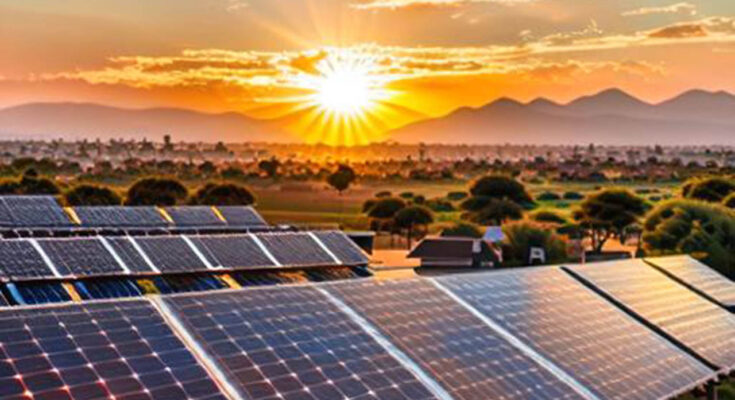Highlights
- Off-grid solar energy systems are a solution to energy poverty and climate change.
- 70 million more people gained access to electricity through off-grid solar power between 2019 and 2022, bringing the total number of people accessing energy through off-grid solar solutions to 490 million globally.
- Productive use of solar energy (PUSE) has enormous potential in sub-Saharan Africa, especially in the agriculture sector, where it can boost primary production and post-harvest processing, unlock higher yields and aggregation opportunities, increase incomes, cut losses, and improve climate resilience.
- Off-grid solar systems have improved farmers’ post-harvest storage, transited others to higher value commercial crop production, and powered machinery to add value to produce.
- The off-grid solar industry supports hundreds of thousands of green jobs in sales, distribution, customer services, and management.
Off-grid solar energy systems are becoming increasingly popular as a solution to two of the world’s most pressing issues – energy poverty and climate change. Not only do they make a significant contribution to achieving universal access to affordable and reliable energy, which is one of the United Nations’ Sustainable Development Goals, but they also help to reduce carbon emissions.
Between 2019 and 2022, 70 million more people gained access to electricity through off-grid solar power. This has brought the total number of people accessing energy through off-grid solar solutions to 490 million globally. Estimates show that connecting 490 million people to solar mini-grids could cut 1.2 billion tonnes of CO2 emissions.
Fossil fuels currently account for 80 percent of global energy production. They are considered the largest contributor to climate change, responsible for over 75 percent of global greenhouse gas emissions and nearly 90 percent of all carbon dioxide emissions. The good news is that cleaner sources of energy like off-grid solar systems are gaining ground. They currently contribute 29 percent of global electricity.
Productive use of solar energy (PUSE) or the utilisation of solar energy for income generation in the production of goods or provision of services for job creation, improved livelihoods, food security and economic empowerment,[4] specifically offers enormous opportunities towards addressing climate change and increasing energy access.
The productive use of solar energy (PUSE) involves using solar energy to generate income by producing goods or providing services. This approach can create jobs, improve livelihoods, enhance food security, and empower people economically. It offers significant opportunities to mitigate climate change and increase access to energy.
In sub-Saharan Africa, 567 million people lack access to electricity and 900 million people lack access to clean cooking. In 2018, an estimated 82 million residents in Uganda, Kenya, and Tanzania lacked reliable electricity. PUSE holds the greatest potential in the agriculture sector in these regions. The sector employs 70% of the population in East Africa, and smallholder farmers account for 75% of the productivity.
Small-scale and rain-fed farming have been the primary factors that have limited the agricultural sector’s growth potential in the region for a long time. However, PUSE applications, which are integrated across the agriculture sector’s production, processing, distribution, and consumption value chains, can significantly boost primary production and post-harvest processing. These applications can help unlock higher yields and aggregation opportunities, increase incomes, reduce losses, and improve climate resilience.
Standalone solar photovoltaic irrigation systems, which are widely used, have the potential to fulfil more than a third of the water requirements for crops in small-scale farms throughout sub-Saharan Africa. These systems have brought about a phenomenal impact in areas where they have been implemented. A study conducted on 400 farmers who owned a solar pump for 4-5 months in Kenya, Uganda, and Tanzania revealed that these farmers experienced a staggering 91% reduction in expenditure. Most of them had shifted from diesel or manual pumping, and 81% of them felt that it had improved their lives. They could count on extra harvest seasons and their incomes increased.
Off-grid solar systems have brought significant improvements to farmers’ post-harvest storage, enabling them to preserve their crops through refrigeration. Moreover, these systems have helped transition some farmers to higher-value commercial crop production and empowered them to add value to their produce by powering machinery. As a result, farm operation costs, such as the use of diesel to power generators, have significantly reduced. Additionally, the off-grid solar industry has contributed to the creation of hundreds of thousands of green jobs in sales, distribution, customer service, and management. In East Africa alone, the sector employed over 77,000 people in 2018, and it is expected to have grown to 350,000 by 2022.
The off-grid solar sector in East Africa is experiencing a dynamic transformation, thanks to various players such as government agencies, private actors, international organisations, and investors. These stakeholders have collaborated actively to create a supportive policy environment for the development of PUSE in East Africa. The governments of Uganda, Tanzania, and Kenya, for instance, have encouraged both local and international private sectors, with the backing of international lenders and funders, to invest heavily in innovations that enhance the accessibility and affordability of renewable energy solutions. In 2017, the off-grid solar sector received about USD 284 million global investments, and East Africa accounted for over half (57%) of these investments.
The significant investment in the off-grid solar sector has led to the emergence of innovative solutions that have further propelled the penetration of off-grid solar technologies. For example, the pay-as-you-go (PAYG) solutions have enabled rural households to afford more extensive solar systems. This solution allows households to purchase solar systems from suppliers by making a down payment, followed by periodic payments that are usually collected through mobile payment platforms.
These innovative solutions partly explain why East Africa accounts for approximately 70% of the solar units sold in Sub-Saharan Africa, which had the highest volume of units sold globally.

